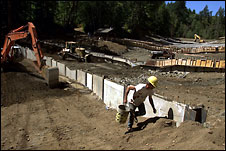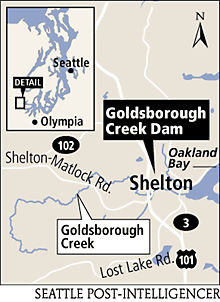forum
library
tutorial
contact

Mason County Dam Gone, and Shelton Applauds Approvingly
by Paul ShukovskySeattle Post-Intelligencer - August 15, 2001
|
the film forum library tutorial contact |

|
Mason County Dam Gone, and Shelton Applauds Approvinglyby Paul ShukovskySeattle Post-Intelligencer - August 15, 2001 |
SHELTON -- Mention removing a dam in arid Eastern Washington and you risk being met by community outrage.
 But in Shelton, a timber company, environmentalists, Indian tribes, government officials and almost everyone else are applauding the state's first dam demolition almost exclusively for environmental restoration.
But in Shelton, a timber company, environmentalists, Indian tribes, government officials and almost everyone else are applauding the state's first dam demolition almost exclusively for environmental restoration.
Now that the dam has been demolished, they plan to rehabilitate Goldsborough Creek and bring back the salmon runs.
For now, the creek is being temporarily diverted through a 50-inch pipe that stretches about a third of a mile.
Crews are regrading the stream bed and installing weirs to make it easier for salmon to make the difficult journey upstream to spawning grounds.
Rep. Norm Dicks, D-Wash., will tour the project this afternoon with representatives of Simpson Timber Co., the Army Corps of Engineers and the state Department of Fish and Wildlife.
Although the removal of the Mason County dam is unique, it isn't the only dam-removal project in the state.
One of two dams on the Elwha River in Clallam County is scheduled to be demolished in 2004 to restore once-bountiful salmon runs on the Elwha.
 And last month, Rep. Jim McDermott, D-Wash., introduced a bill in the House that would set the stage for the removal of four dams on the lower Snake River as early as 2005 -- if federal agencies say that is necessary to preserve endangered salmon in the river, comply with the Clean Water Act or meet obligations to Native American tribes.
And last month, Rep. Jim McDermott, D-Wash., introduced a bill in the House that would set the stage for the removal of four dams on the lower Snake River as early as 2005 -- if federal agencies say that is necessary to preserve endangered salmon in the river, comply with the Clean Water Act or meet obligations to Native American tribes.
The measure, which McDermott introduced along with 20 co-sponsors, calls for federal agencies to begin planning to remove the Eastern Washington dams by studying how breaching them would affect farmers, transportation and energy production in the region.
But unlike dams in Eastern Washington, the Goldsborough dam had no longer served a purpose.
The 35-foot-tall dam, owned by Simpson, was built by another company in 1921 to provide electricity and impound water. But it hasn't produced electricity for years. And when high water in the mid-1990s destroyed a pipe system, the dam became a liability, said Larry Gill, Simpson's environmental services manager.
So Simpson teamed up with the state and federal governments to fund tearing the structure down. The costs are split among the three entities with Simpson picking up about a sixth of the $4.5 million project.
"There's really no controversy because the dam has outlived its usefulness," said Mike Padilla, the project manager for the Army Corps of Engineers, which is overseeing the project. "And everybody is motivated to get rid of it for fish passage."
By this fall, Goldsborough should be running free again. Twelve miles of prime habitat will suddenly become available for coho, chum, steelhead and cutthroat that are looking upstream for love.
The removal helps Simpson fulfill its habitat protection and restoration responsibilities.
But no one will be happier than the members of the nearby Squaxin Island Tribe, which for years played the role of midwife to get money for the project.
 "The Squaxin have been key in making Goldsborough happen," said Shawn Cantrell, Northwest regional director of the environmental group, Friends of the Earth.
"The Squaxin have been key in making Goldsborough happen," said Shawn Cantrell, Northwest regional director of the environmental group, Friends of the Earth.
"The tribe was an early and vocal advocate for restoring that stream and its salmon runs."
For years, the tribe had been talking with Simpson about removing the dam, particularly when maintenance costs began to skyrocket in the 1990s.
Then, at an unrelated meeting in the mid-1990s, tribal officials had a chance encounter with an undersecretary of the Army who oversaw the Corps of Engineers.
They later traveled to Washington to try to secure money, and worked with Dicks to get the funding back on track when the project was postponed.
The Shelton area stands to benefit by having a fertile salmon stream flowing through town. And Simpson is likely to turn a portion of the creek's banks into a public park.
"I haven't heard any naysayers," Shelton Mayor John Tarrant said. "There's a lot of real pluses for the community in terms of stream enhancement and recreation. And there shouldn't be any real negative effects."
Andy Whitener, vice chairman of the Squaxin Island Tribe, agreed.
"It has been a dream of the tribe for many years," Whitener said. "Shelton is one of our original village sites, so it's very important to us."
learn more on topics covered in the film
see the video
read the script
learn the songs
discussion forum
